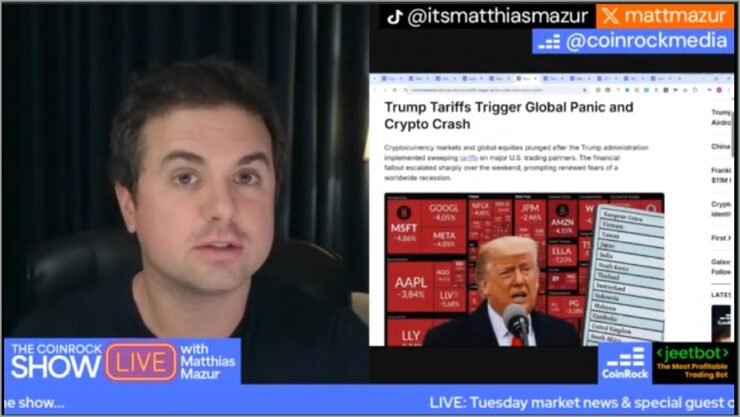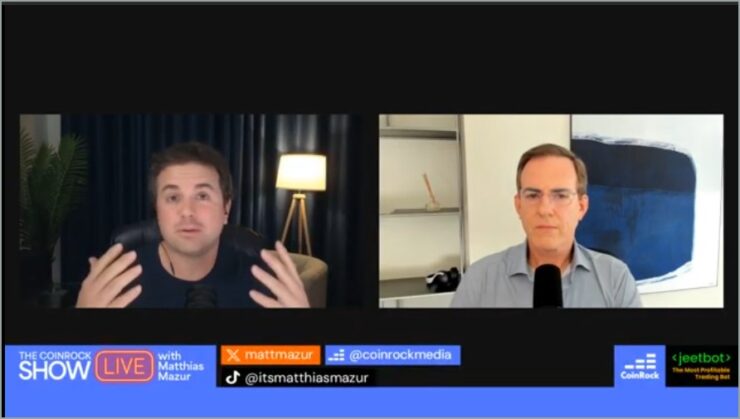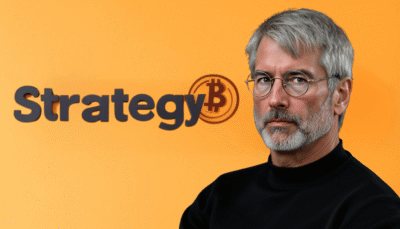For once, it was a green Tuesday in the crypto markets — a welcome break from the brutal correction that defined early Q2. But the real action on The CoinRock Show came not from daily price movements but from a power-packed conversation with none other than William Quigley, co-founder of Tether, and a seasoned investor who’s helped shape digital economies since the early Web1 era.
Host Matthias Mazur, still recovering from a heavy fever, pushed through to deliver what turned out to be one of the most insight-packed episodes yet, covering everything from macro volatility and U.S. tariffs to how stablecoins may finally be ready to unlock mass adoption in Web3.
Markets Rebound — But Macro Clouds Loom
Matthias kicked things off with a light market rundown, noting the sudden (if temporary) bounce across Bitcoin and altcoins. But despite the brief relief, he painted a sober picture of what’s next: macro uncertainty, lack of bullish catalysts, and institutional hesitation are likely to keep markets choppy for the foreseeable future.

Referencing a hedge fund friend managing over $2 billion, Matthias explained why many major players went net short as early as Q3 2024, betting against overconfidence in a so-called “Trump bounce.”
“And so I think now what’s happening is the market is realizing that, oh, this is not a few days. At best, a few weeks, probably a few months. So then the question is, do we see a big V-shaped recovery like we did during COVID, right? I mean, during, after COVID, during COVID,” he said.
Enter William Quigley: The Man Behind Tether
When William Quigley finally joined the stream, the conversation went from tactical to philosophical in minutes.
William, who co-founded Tether after pioneering virtual goods trading in the 90s, shared a candid origin story of stablecoins. His journey from virtual item marketplaces to programmable money revealed one theme: solve real-world problems and scale trustlessly.

Matthias and Williams Discussing about the early days of Tether
Quigley explained why stablecoins were never optional for DeFi — they’re essential for calculating profit and loss.
“Because around the world, it’s often very hard to get access to payment systems, and particularly in the developing world. So that’s what got us interested in it.”
Quigley believes that tokenized fiat is inevitable — not just for crypto-native use cases but for global payments, remittances, and financial access.
Despite regulatory resistance in the U.S., he argues that stablecoins offer something rare in tech: upside without trade-offs.
“I would say the Federal Reserve and then other people who were proponents of tokenizing fiat were not very effective or even ignored what the benefits were to the consumer or to the business,” he emphasized.
“The benefits are massive, but they weren’t being articulated.”
He pointed to Zuckerberg’s failed Libra pitch as a missed opportunity to educate Congress and the public.
“This was the first time there was a spokesperson for a stable coin in front of Congress. And what was depressing about it is Zuckerberg knew nothing about Libra. It was so obvious that maybe a few days before his testimony, he got a briefing doc.”
Perception, Not Tech, Is the Bottleneck
Both Matthias and Quigley agreed: the tech is here. What’s lacking is understanding.
From U.S. banking crackdowns to compliance paranoia, the barriers to adoption are no longer technical — they’re narrative-based.
Quigley criticized the myth that CBDCs will suddenly give governments more control.
“The notion that you think, because you don’t have a central bank digital currency, the U S government has no way to monitor or even to restrict how you use your money is naive,” he said, citing the Patriot Act and the silent role of banks in financial surveillance.
“The amount of information that financial institutions send to the US government that gives them every single iota of information about what you’re doing with your money and, and, and how much you have, and, and they can, with the snap of a finger, freeze your assets.”
The Path Forward: Gaming, DeFi, and Infrastructure
Quigley revealed that his attention today is split between blockchain gaming, DeFi infrastructure, and stablecoin regulation. From his vantage point, three things will drive the next crypto cycle:
- Tokenized payments with stablecoins
- Blockchain-based lending (DeFi with proper collateral models)
- Institutional-grade gaming ecosystems using NFTs and on-chain assets
He described the traditional repo market as the largest short-term lending system in the world — and said DeFi, using bearer assets like crypto, could one day outscale it.
“So the biggest lending market in the world, your audience may or may not know, is the repo market. For those of you who maybe aren’t on Wall Street, repos and reverse repos. So this market, I like to think of it as the pawn shop of global finance.”
Final Thoughts: The Halving Playbook May Be Changing — But Opportunity Remains
As the show wound down, William Quigley left the audience with a thoughtful reflection — less a warning, more a strategic pause. Looking at the current cycle, he noted that 2025 was widely expected to be the post-halving bull run, much like past cycles. The April 2024 halving had occurred right on schedule, and by late 2024, market signals pointed to a continuation of the familiar uptrend.
But now, with Bitcoin still far below the $200K milestone that historical patterns might have predicted for this stage, Quigley raised an open question: what if the cycle has shifted?
“Is the 2025 bull market canceled? Does it get moved for whatever reason into 2026?”
Rather than sounding alarmed, he pointed to the complexity of today’s macro environment and emphasized that assumptions based on past cycles may no longer be reliable. What followed was an important reminder: don’t get lazy with patterns.
Even if the typical trajectory doesn’t play out, the window ahead could be full of asymmetric opportunities — for those who are paying attention.
“There’s going to be a lot of money made. Because if you are right, you are going to be able to acquire crypto at very attractive prices. But what what the right direction is, I don’t know. But I think that’s to be figured out over the next three or four months.”
In short, the map may look different — but that doesn’t mean the treasure is gone. It just means you have to think for yourself.
Where You Can Find William Quigley
You can follow William Quigley and explore more of his work across the blockchain space through his verified profiles and project links:
- Twitter: @WilliamEQuigley
- LinkedIn: William E. Quigley
- WAX Official Site: www.wax.io




